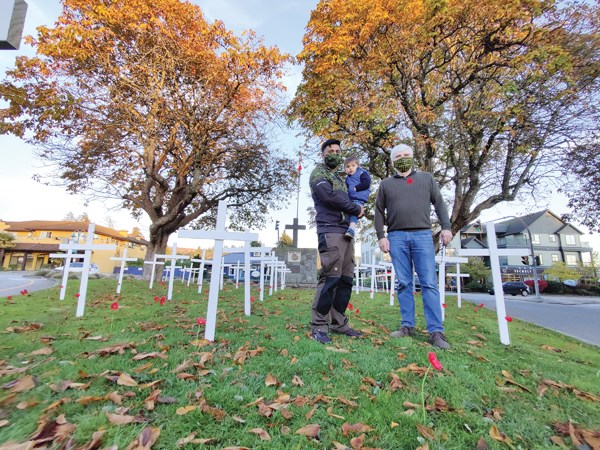There will not be a Remembrance Day ceremony at the cenotaph in downtown Sechelt this year, but the monument is still being used to mark the occasion.
More than 40 white crosses and poppies were installed at the cenotaph on Sunday and will remain through November 11.
The project was organized by Dr. Paul Dhillon, a local physician who is also a medical officer with the 12 Field Ambulance, a Canadian Forces reserve unit based in Vancouver.
Dhillon, who has been a reservist for the past six years, helped organize a similar display with a Rotary Interact club at South Delta Secondary in 1999 – a tradition that has carried on every year since. Each of the crosses Dhillon and his friends built included the name of someone from the community who’d gone off to war and not returned.
Dhillon said his original goal was to have the Chatelech Interact students involved with the cross display and make it a bigger community project – and to also include the names of those from Wilson Creek, Sechelt and Halfmoon Bay who’d lost their lives – but the pandemic made that impractical.
Dhillon said knowing that there weren’t going to be the usual Remembrance Day ceremonies, he wanted to forge ahead and create something.
“I told [Sechelt Legion president Bill McLean] my concept idea, he said he’d run it by the board, and he said we’re good to go – within 48 hours.”
So with the support of the Legion and some help from his wife Sarah he built and painted more than 40 crosses in the space of about two weeks.
“The [pandemic] situation has made this installation so much more poignant,” he said. “It’s allowing people over 11 days to socially distance and walk by and drive by and even if they don’t get that two minutes of silence on November 11, they have an extended time and an extended space in which to just pause and reflect.”
Dhillon said he hopes that next year he’ll be able to follow through on the vision of making the cross installation a bigger project and start doing the research to find the names of the fallen from the Sechelt area to add to the crosses.
“People left Sechelt and small towns across the country, and never got to see them again,” he said.
“I think the beauty of that park and that place really brings it home that there’s people that leave and never come back.”



